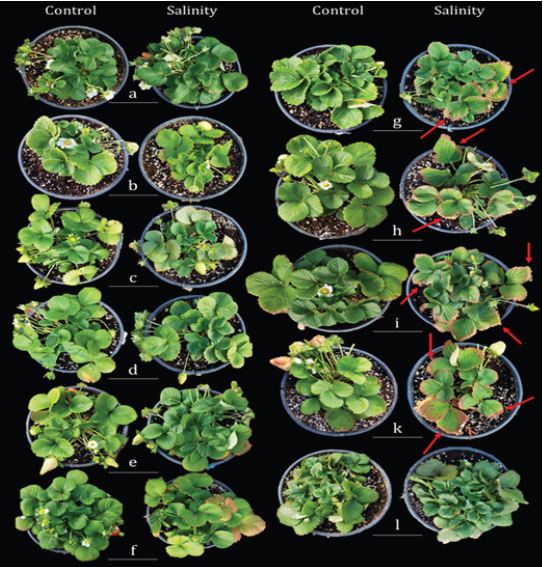- Submissions

Full Text
Environmental Analysis & Ecology Studies
Comparison of Advanced Selection Level Genotypes with Widely Grown Varieties of Strawberry Under Salinity Condition
Furkan Cihad Akbaş*, Mehmet Ali Sarıdaş and Sevgi Paydaş Kargı
Department of Horticulture, Çukurova University, Turkey
*Corresponding author: Furkan Cihad Akbaş, Department of Horticulture, Çukurova University, Balcali, Adana, Turkey
Submission: March 09, 2021; Published: December 03, 2021

ISSN 2578-0336 Volume9 Issue3
Abstract
Salinity, or salt stress, disrupts the absorption of nutrients, reduces water intake and photosynthetic activity, thus decreasing the yield in plants with loss of biomass. In this ongoing study, widely grown varieties along with advanced selection genotypes, which have promising feature, are being used. In the first year of this study, which is planned to last two years, genotype and varieties’ tolerance levels in salinity stress will be determined and in the next year, commercial biostimulant and abscisic acid will be applied to selected plants (sensitive, semi-tolerant and tolerant) in order to provide salt tolerance. Our preliminary results indicate that advanced selection genotypes have better salinity tolerant in comparison with common varieties. Thus, it is thought that the study will provide data for both breeding and molecular research, and recommend the use of commercial products for large-scale producers.
Keywords: advanced-selected genotypes, salt tolerance, vegetative parameters
Introduction
Epidemiological studies conducted in the last decade emphasize the importance of consuming functional foods rich in antioxidants and bioactive compounds in order to reduce the risk of cancer, obesity, cardiovascular diseases, as well as oxidative stress and inflammation [1]. It has been reported that strawberry is species of fruit rich in components, particularly anthocyanins content [2], that have a protective effect on these diseases. Moreover, it is considered one of the most consumed berries [3]. The production value of strawberries in our country has reached 486.705 tons on an area of 160.899 da in 2019 and it is expected to increase by 12.3% in 2020 compared to the previous year [4]. On the other hand, world strawberry production in 2019 was 8.9 million tons along with rising by 11% in the last 5 years [5]. Many studies have been carried out on practices to reduce the adverse effects of salinity stress in strawberries [6], which are sensitive to abiotic stress factors [7]. However, these studies consist mostly local varieties and experiments focused on varieties currently grown in our country are limited [8].
Case Presentation
Materials of the study are ‘7-10’ (a), ‘33’ (b), ‘59’ (c), ‘61’ (d), ‘103’ (e), ‘291’ (f) genotypes, which has obtained as a result of our university’s breeding studies and reached to ‘advanced selection’ level, ‘Amiga’(g), ‘Festival’ (h), ‘Sabrina’ (i), ‘Rubygem’ (k) varieties, which are commonly grown in our country, and ‘Osmanlı’ (l) variety, which is known for its distinctive aroma. This experiment has been conducted. Plasnts have been irrigated with saline water (EC: 2.5 dS/m) while tap water (EC: 0.7 dS/m) has being used to control plants since December/2020.
Discussion
We found that current common variaties in Turkey have shown sensitivity to salinity stress (red arrow in Figure 1; g, h, i, k). It also was seen that, interestingly, advanced selection genotypes along with Osmanlı variety continue to show consistent vegetative growing even after 3 months of irrigation with saline water (Figure 1; a, b, c, d, e, f, l). These results up to date indicate that advanced selections have great potential to become variety and could be used as parent for future breeding and molecular studies. Future prospect on responds of these plants to salinity will be examined and we hope to be able to reduce the adverse effects of global climate changes on crop production.
Figure 1: Responds of strawberry plants in the experiment to salinity application after 3 months.

References
- Battino M, Giampieri F, Cianciosi D, Ansary J, Chen X, et al. (2020) The roles of strawberry and honey phytochemicals on human health: A possible clue on the molecular mechanisms involved in the prevention of oxidative stress and inflammation. Phytomedicine 86: 153170.
- He K, Li X, Chen X, Ye X, Huang J, et al. (2011) Evaluation of antidiabetic potential of selected traditional Chinese medicines in STZ-induced diabetic mice. J Ethnopharmacol 137(3): 1135-1142.
- Battino M, Forbes HYT, Gasparrini M, Afrin S, Cianciosi D, et al. (2019) Relevance of functional foods in the Mediterranean diet: the role of olive oil, berries and honey in the prevention of cancer and cardiovascular diseases. Critical Reviews in Food Science and Nutrition 59(6): 893-920.
- TUIK (2020) Statistic Institute of Turkey.
- FAO (2019) Food and Agricultural Data.
- Jamalian S, Truemper C, Pawelzik E (2020) Jasmonic and Abscisic Acid Contribute to Metabolism Re-adjustment in Strawberry Leaves under NaCl Stress. International Journal of Fruit Science 20(Suppl2): 1-22.
- Giné BJ, Echeverría G, Ubach D, Larrigaudière C, Luisa ML (2016) Biochemical and phsysiological changes during fruit developmente and ripening of two sweet cherry varieties with different levels os cracking tolerance. Plant Pshysiology and Biochemistry 111: 216-225.
- González JSL, Castillo GAM, del Rosario García MM, Valdez ALA, Ybarra MC, et al. (2020) Response of strawberry CV festival to salinity. Revista Fitotecnia Mexicana 43(1): 53-60.
© 2021 © Furkan Cihad Akbaş. This is an open access article distributed under the terms of the Creative Commons Attribution License , which permits unrestricted use, distribution, and build upon your work non-commercially.
 a Creative Commons Attribution 4.0 International License. Based on a work at www.crimsonpublishers.com.
Best viewed in
a Creative Commons Attribution 4.0 International License. Based on a work at www.crimsonpublishers.com.
Best viewed in 







.jpg)






























 Editorial Board Registrations
Editorial Board Registrations Submit your Article
Submit your Article Refer a Friend
Refer a Friend Advertise With Us
Advertise With Us
.jpg)






.jpg)














.bmp)
.jpg)
.png)
.jpg)










.jpg)






.png)

.png)



.png)






